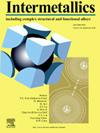Ti-46Al-8Nb-1.5Cr-xC合金低长径比Ti2AlC颗粒的原位形成与调控及其对显微组织和力学性能的影响机制
IF 4.8
2区 材料科学
Q2 CHEMISTRY, PHYSICAL
引用次数: 0
摘要
为了获得体积分数高、长径比低的Ti2AlC颗粒,并阐明其形成机理,采用真空电弧熔炼法制备了Ti-46Al-8Nb-1.5Cr-xC合金。系统地研究了Ti2AlC的片层集落大小、Ti2AlC颗粒含量和形貌演变、相组成和力学性能,并讨论了相应的机理。结果表明,随着含碳量从0.5 at增加到3.0 at。%时,B2相逐渐减少,最终消失,而片层集落的平均尺寸从97 μm细化到39 μm。同时,Ti2AlC颗粒的形貌由最初的细长型转变为等轴型,长径比由9.33减小到3.28。低纵横比Ti2AlC颗粒的比例从4.1%增加到77.8%。形成的Ti2AlC颗粒不仅作为β相的非均相成核位点,而且阻碍α相的生长,从而为层状集落细化提供了基础。TiC颗粒数量的增加,加上(0001)基面与其他晶面之间表面能差的减小,共同抑制了Ti2AlC颗粒的生长。力学性能方面,抗压强度由1491 MPa提高到2299 MPa,应变由17.66%提高到34.48%。强度的增强主要是Ti2AlC颗粒的片层集落细化和沉淀强化。此外,B2相的还原和Ti2AlC颗粒的止裂作用有助于提高合金的韧性。本文章由计算机程序翻译,如有差异,请以英文原文为准。
In-situ formation and regulation of Ti2AlC particles with low aspect ratio and their influence mechanisms on microstructure and mechanical properties in Ti-46Al-8Nb-1.5Cr-xC alloy
To obtain a high volume fraction of Ti2AlC particles with a low aspect ratio and to elucidate their formation mechanism, Ti-46Al-8Nb-1.5Cr-xC alloys were fabricated using vacuum arc melting. A systematic investigation was conducted on the lamellar colony size, Ti2AlC particle content and morphology evolution, phase constituents, and mechanical properties, along with a discussion of the corresponding mechanisms. The results show that as the carbon content increases from 0.5 to 3.0 at.%, the B2 phase gradually decreases and eventually disappears, while the average lamellar colony size is refined from 97 to 39 μm. Simultaneously, the morphology of Ti2AlC particles changes from initially elongated shapes to equiaxed shapes forms, with the aspect ratio decreasing from 9.33 to 3.28. The proportion of low-aspect-ratio Ti2AlC particles increases from 4.1 to 77.8 %. The formed Ti2AlC particles not only act as heterogeneous nucleation sites for the β phase but also impede the growth of the α phase, thereby providing the basis for lamellar colony refinement. The increased number of TiC particles, combined with the reduced surface energy difference between the (0001) basal plane and other crystallographic planes, jointly inhibited the growth of Ti2AlC particles. In terms of mechanical properties, the compressive strength increases from 1491 to 2299 MPa, and the strain improves from 17.66 to 34.48 %. The enhancement in strength is mainly attributed to lamellar colony refinement and precipitation strengthening by Ti2AlC particles. Moreover, the reduction of the B2 phase and the crack-arresting effect of Ti2AlC particles contribute to the improved toughness of the alloy.
求助全文
通过发布文献求助,成功后即可免费获取论文全文。
去求助
来源期刊

Intermetallics
工程技术-材料科学:综合
CiteScore
7.80
自引率
9.10%
发文量
291
审稿时长
37 days
期刊介绍:
This journal is a platform for publishing innovative research and overviews for advancing our understanding of the structure, property, and functionality of complex metallic alloys, including intermetallics, metallic glasses, and high entropy alloys.
The journal reports the science and engineering of metallic materials in the following aspects:
Theories and experiments which address the relationship between property and structure in all length scales.
Physical modeling and numerical simulations which provide a comprehensive understanding of experimental observations.
Stimulated methodologies to characterize the structure and chemistry of materials that correlate the properties.
Technological applications resulting from the understanding of property-structure relationship in materials.
Novel and cutting-edge results warranting rapid communication.
The journal also publishes special issues on selected topics and overviews by invitation only.
 求助内容:
求助内容: 应助结果提醒方式:
应助结果提醒方式:


